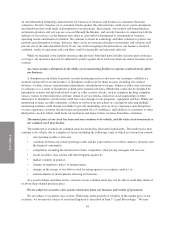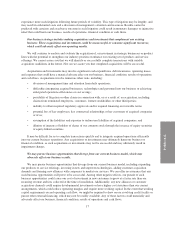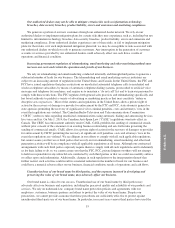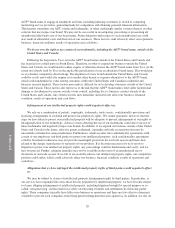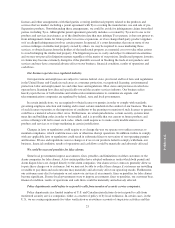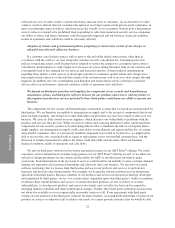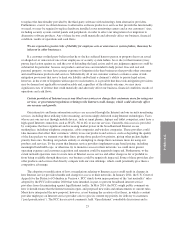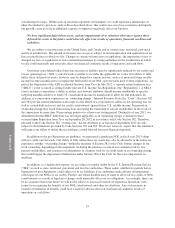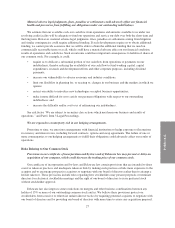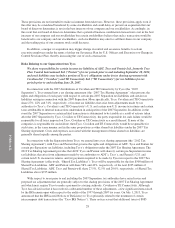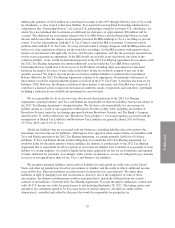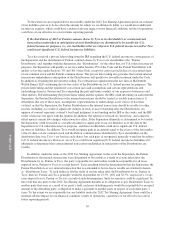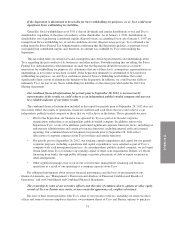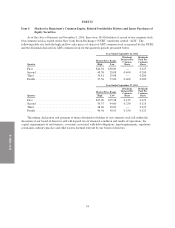ADT 2014 Annual Report Download - page 92
Download and view the complete annual report
Please find page 92 of the 2014 ADT annual report below. You can navigate through the pages in the report by either clicking on the pages listed below, or by using the keyword search tool below to find specific information within the annual report.
FORM 10-K
sufficient liquidity to meet our foreseeable needs, our access to and the cost of capital could be negatively
impacted by disruptions in the financial markets or changes in our credit ratings. In recent years, the credit
markets experienced significant dislocations and liquidity disruptions, and similar disruptions in the credit
markets in the future could make financing terms for borrowers unattractive or unavailable. These factors may
make it more difficult or expensive for us to access the capital markets if the need arises. In addition, these
factors may make it more difficult for our suppliers to meet demand for their products or for potential strategic
partners to commence new projects, as they may experience increased costs of debt financing or difficulties in
obtaining debt financing. Disruptions in the financial markets have had adverse effects on other areas of the
economy and have led to a slowdown in general economic activity that may continue to adversely affect our
businesses. These disruptions may have other unknown adverse effects. One or more of these factors could
adversely affect our business, financial condition, results of operations or cash flows.
In fiscal 2013, Standard and Poor’s Rating Services, Moody’s Investors Service, Inc. and Fitch Ratings
downgraded the Company from BBB to BB-, from Baa2 to Ba2 and from BBB+ to BBB-, respectively. Our
credit ratings are based upon information furnished by us or obtained by a rating agency from its own sources
and are subject to revision, suspension or withdrawal by one or more rating agencies at any time. Rating agencies
may review the ratings assigned to us due to developments that are beyond our control, including as a result of
new standards requiring the agencies to reassess rating practices and methodologies. If further downgrades in our
credit ratings were to occur, it could result in higher interest costs under our revolving credit facility. It could also
cause our future borrowing costs to increase and reduce our access to capital.
Covenants in our debt instruments may adversely affect us.
Our revolving credit facility contains customary covenants, including a limit on the ratio of debt to earnings
before interest, taxes, depreciation, and amortization (“EBITDA”), a minimum required ratio of EBITDA to
interest expense and limits on incurrence of liens and subsidiary debt. In addition, the indenture governing our
senior unsecured notes contains customary covenants including limits on liens and sale/leaseback transactions.
Our ability to meet our financial covenants can be affected by events beyond our control, and we cannot
provide assurance that we will meet those tests. A breach of any of these covenants could result in a default under
our revolving credit facility or our indenture. Upon the occurrence of an event of default under our revolving
credit facility or our indenture, the lenders or trustees could elect to declare all amounts outstanding thereunder to
be immediately due and payable and, in the case of credit facility lenders, terminate all commitments to extend
further credit. If the lenders or trustees accelerate the repayment of borrowings, we cannot provide assurance that
we will have sufficient assets to repay our revolving credit facility and our other indebtedness. Furthermore,
acceleration of any obligation under any of our material debt instruments will permit the holders of our other
material debt to accelerate their obligations, which could have a material adverse effect on our financial
condition. See Item 7. Management’s Discussion and Analysis of Financial Condition and Results of Operations.
We may continue to increase our debt or raise additional capital in the future, which could affect our
financial health and may decrease our profitability.
We may continue to increase our debt or raise additional capital in the future, subject to restrictions in our
revolving credit facility and indenture and any debt agreements covering debt incurred subsequent to the date of
this report. If our cash flow from operations is less than we anticipate, or if our cash requirements are more than
we expect, we may require more financing. However, debt or equity financing may not be available to us on
terms acceptable to us, if at all. If we incur additional debt or raise equity through the issuance of additional
capital stock, the terms of the debt or our capital stock issued may give the holders rights, preferences and
privileges senior to those of holders of our common stock, particularly in the event of liquidation. The terms of
the debt may also impose additional and more stringent restrictions on our operations than we currently have. If
we raise funds through the issuance of additional equity, your percentage ownership in us would decline. If we
are unable to raise additional capital when needed, it could affect our financial health.
26


